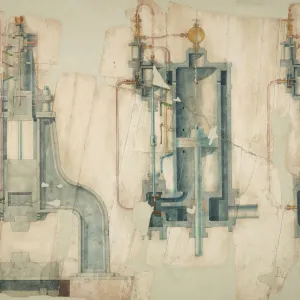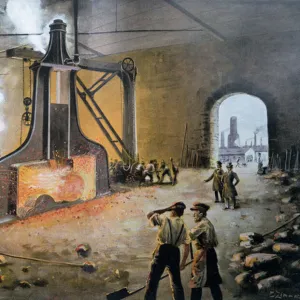Home > Mary Evans Prints Online > Inst. of Mechanical Engineers
2 ton steam hammer
![]()

Wall Art and Photo Gifts from Mary Evans Picture Library
2 ton steam hammer
Foundation, base-plate, anvil for a 2 ton steam hammer, plan elevation and details Date: 1847
Mary Evans Picture Library makes available wonderful images created for people to enjoy over the centuries
Media ID 5081738
© Mary Evans Picture Library 2015 - https://copyrighthub.org/s0/hub1/creation/maryevans/MaryEvansPictureID/10509776
1847 Bridgewater Engineering Foundry Gaskell Hammer Machinery Nasmyth Tools
EDITORS COMMENTS
This print depicts the intricate design and impressive scale of a 2-ton steam hammer from the year 1847. The hammer, a marvel of engineering innovation, is shown in various perspectives, including a plan elevation and detailed drawings of its foundation, base-plate, and anvil. The steam hammer, a crucial tool in foundries during the Industrial Revolution, was used to shape and forge metal components with great force and precision. The steam hammer's design was the result of collaboration between pioneering engineers, including Henry Maudslay, James Nasmyth, and Edward Gaskell. These visionaries harnessed the power of steam to create a tool that could exert far greater force than traditional hammers, revolutionizing the manufacturing process. The print reveals the intricate machinery that powered the steam hammer. A boiler, filled with water, was heated to produce steam. The steam was then directed to a cylinder, which in turn powered a piston. The rapid movement of the piston transferred the energy to the hammer head, which was swung with immense force to shape metal. The transportation of such a large and heavy piece of machinery would have been a significant challenge during the 1840s. The print does not show the means of transport, but it is known that the steam hammer was often transported in pieces and reassembled at the destination. This would have required careful planning and coordination, as well as the use of specialized transport infrastructure, such as canals and railways. The steam hammer, with its impressive design and innovative use of steam power, represents a pivotal moment in the history of machinery and engineering. This print offers a fascinating glimpse into the past, providing a window into the world of 19th-century foundries and the pioneering engineers who shaped the industrial landscape.
MADE IN THE USA
Safe Shipping with 30 Day Money Back Guarantee
FREE PERSONALISATION*
We are proud to offer a range of customisation features including Personalised Captions, Color Filters and Picture Zoom Tools
SECURE PAYMENTS
We happily accept a wide range of payment options so you can pay for the things you need in the way that is most convenient for you
* Options may vary by product and licensing agreement. Zoomed Pictures can be adjusted in the Cart.




